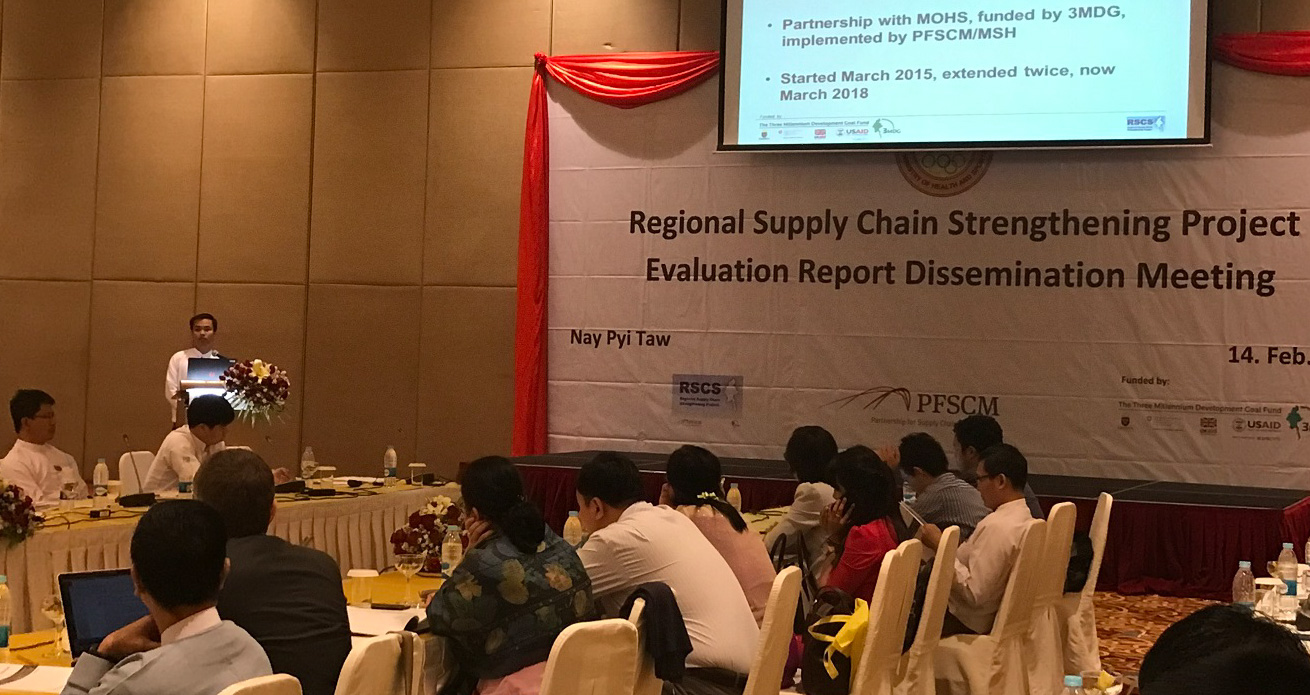A project to assist the Myanmar Ministry of Health and Sports (MoHS) to improve supply chain management in public sector health systems at the regional and lower levels through system improvements and capacity building has yielded satisfying results in just one year of implementation.
The Regional Supply Chain Strengthening (RSCS) project, funded by the Three Millenium Development Goal (3MDG) fund and implemented by the Partnership for Supply Chain Management (PFSCM), showed an overall improvement of 21%, with logistics management information system (LMIS) implementation advancing the most, from a poor rating to a good rating between 2016 and 2017.
The RSCS project was initiated under the 3MDG fund to help the MoHS implement an LMIS and related strengthening initiatives at the lowest health system level in three regions: Ayeyarwady, Bago, and Magway. These three regions, with 79 townships and 3,738 health care facilities, represent nearly 30% of Myanmar’s population.
Baseline assessment determines supply chain needs
To gauge the condition of the health commodity supply chain, a baseline study was conducted at 301 (8%) of the basic health facilities in the three regions between June 2016 to July 2016.
The facilities were scored according to the RSCS performance appraisal scoring system for supply chain management, which uses five performance levels: bad, poor, moderate, adequate, and good. Five supply chain management categories were evaluated, namely human resources, LMIS, supply, storage conditions, and stock status.
Some of the main findings of the baseline study included:
- A lack of an organized supply chain structure.
- A lack of structured information flow between different levels of the supply chain.
- Basic health staff inadequately trained in stock management and using a time-consuming stock record-keeping system.
- Many incidents of stockout and excess/unused medicines.
- Actions taken to improve supply chain management
After identifying the key opportunities for improvement, the RSCS project team collaborated closely with the MoHS, especially at the regional and township levels, to:
- Implement a harmonized LMIS for essential medicines and health commodities.
- Train MoHS staff on supply chain management.
- Help the MoHS introduce logistics management units at the regional and township levels.
- Strengthen supply chain management by changing from a “push” to “pull” system for re-supply (in a pull-based supply chain, procurement and distribution are demand driven rather than to forecast).
The LMIS consists of a paper-based monthly reporting form that health facilities use to record consumption and stock-level data and then send to the township level for further aggregation into an electronic data system.
Further, a pilot of mSupply, an electronic LMIS data aggregation and reporting system, has been implemented in 15 townships (five townships in each region) since November 2016. After evaluating the pilot, the MoHS agreed to roll out mSupply to 64 more townships by May 2017.
These information streams are expected to make it easier for managers to avoid stockouts or excess medicines with risk of expiry by, for example, reallocating stock from one facility to another or from one township or region to another.
During the LMIS implementation, RSCS trained local staff on key supply chain management topics and provided hardware, software, and tools such as stock books and forms.
Overall results
In 2017, an endline study was conducted at the same 301 health facilities to measure the progress and success of the LMIS and other strategies.
Of the five categories, the biggest impact was made in the LMIS area, which moved from a poor to a good rating. The LMIS focus streamlined record keeping and improved stock management practices, including the performance of regular physical stock checks and the use of first expired first out (FEFO) distribution, which can reduce expiry.
The human resources score also improved significantly from moderate to good, which likely resulted from intensive RSCS training on proper record keeping, used of paper-based reporting forms, and stock management improvements.
The supply conditions area moved from poor to moderate, while the storage conditions and stock status areas improved from moderate to adequate. These improvements resulted from a combination of RSCS training activities, LMIS activities, and the wide distribution of the Guidelines for the Storage of Essential Medicines and other Health Commodities, which the project produced in the local language. In addition, in 2015 during the preparation phase, the RSCS team visited many facilities and gave hands-on product management advice to the basic health facility staff.
Stockouts continued to remain high, owing to procurement practices outside of RSCS’s influence, but with long-term implementation and continued improvement, the LMIS is expected to also help reduce stockouts.
The overall RSCS supply chain system score, which is the average of the five categories, improved from 47% to 68%, which indicates an adequately functioning supply chain per the criteria established by RSCS and 3MDG as part of the project’s monitoring and evaluation

